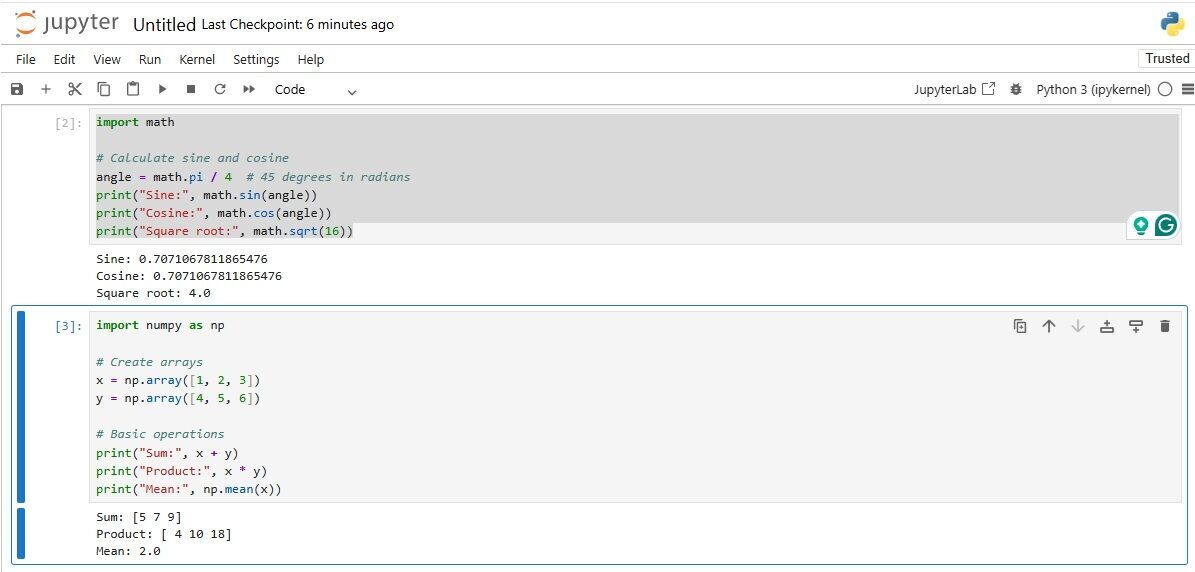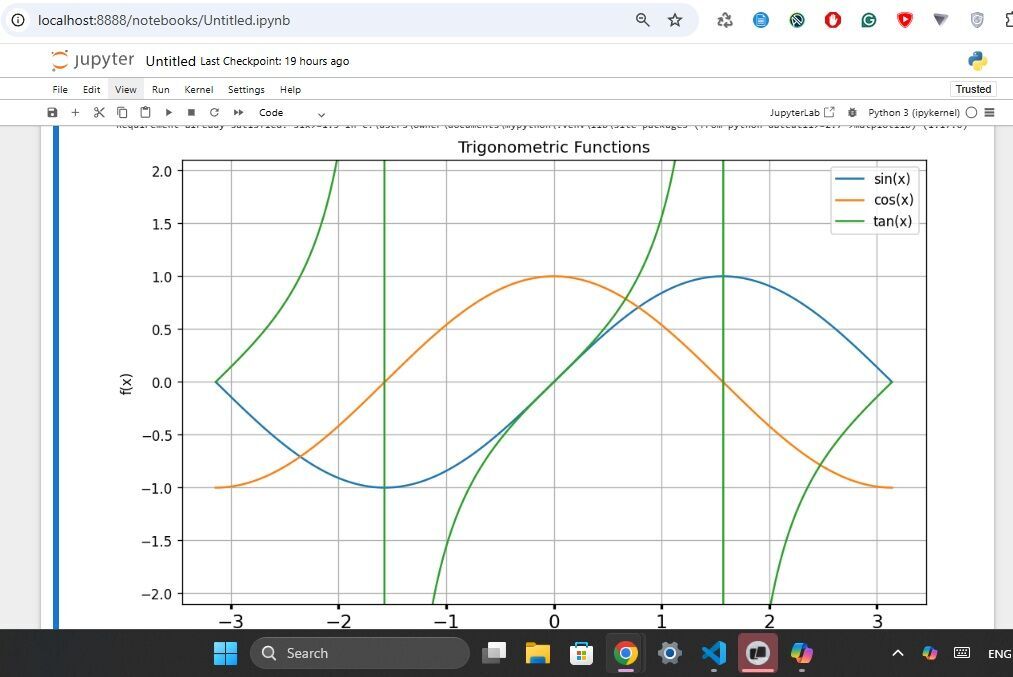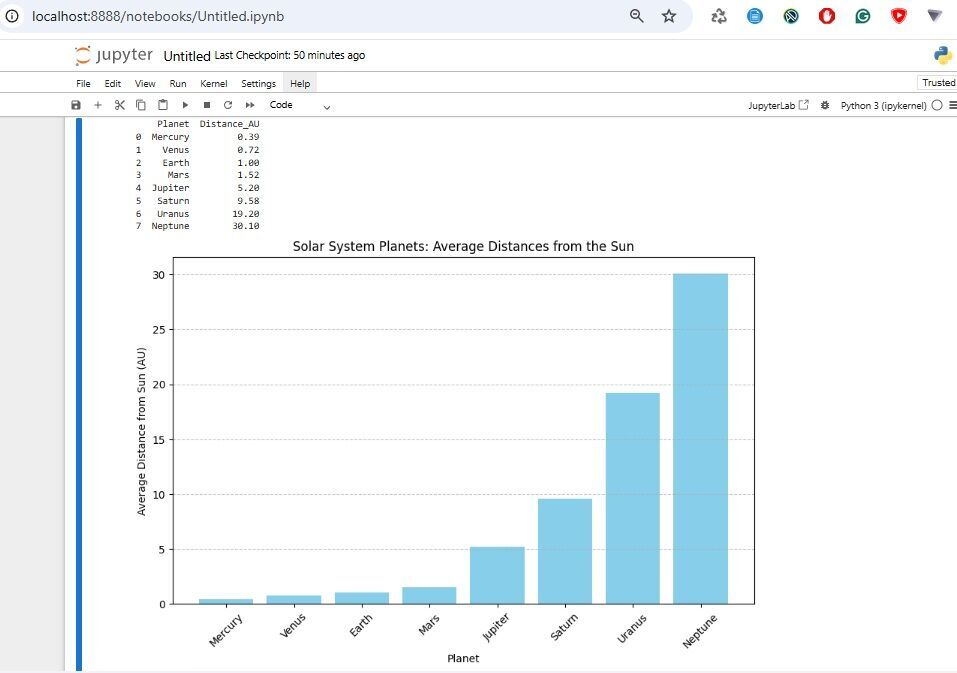
|
 |
 |
Assumption is the mother of all screw-ups, Anonymous.

Jupyter Notebook is an open-source web application that allows users to create and share documents containing live code, visualizations, mathematical equations, and narrative text. It is a powerful and widely used tool for data analysis, machine learning, scientific computing, and education due to its interactive and flexible nature.
Its key features include:
$e^{i\pi}+1=0$
$$\sum_{k=0}^{\infty}\frac{z^k}{k!}=e^z$$
Output: $e^{i\pi}+1=0$
$$\sum_{k=0}^{\infty}\frac{z^k}{k!}=e^z$$jupyter nbconvert ‐‐to html your_notebook.ipynb
Notebook vs. Lab: The classic app is Jupyter Notebook (jupyter notebook). The more modern UI is JupyterLab (jupyter lab); everything here works in both unless noted.
Install Jupyter Notebook using pip (pip install notebook or python -m pip install notebook) or conda (conda install -c conda-forge notebook). After installation, start the notebook server by running jupyter notebook in the terminal. This command starts a web server from a terminal in your project folder and opens your browser to http://localhost:8888. Stop the server with Ctrl + C in the terminal.
Core shortcuts (Help, Show Keyboard Shortcuts…): A/B insert cell above/below; DD delete; M/Y: Change cell to Markdown/Code. Shift+Enter: Run cell, select next.
Shift + Enter to execute and move to the next cell or Ctrl + Enter to execute in-place (stay). Save NoteBook: File, Save Notebook (.ipynb files) or Ctrl + S.
Cells execute in the order you run them within the same kernel. Kernel, Restart kernel clears memory; Run, Run All Cells re-executes top-to-bottom for reproducibility. Kernel, Interrupt Kernel to stop long-running computations.
%pip install numpy pandas matplotlib scipy sympy, %timeit x = [i for i in range(1000000)] (timing).Markdown or M); (ii) Write Markdown directly; (iii) Run the cell to render.# Header Example
- Bullet point
- Another bullet point
[Link to Google](https://www.google.com)
Inline math: $e^{i\pi} + 1 = 0$
Display math:
$$
\sum_{k=0}^{\infty} \frac{z^k}{k!} = e^z
$$
# For simple calculations, use the built-in math module in a Jupyter cell.
import math
# Calculate sine and cosine
angle = math.pi / 4 # 45 degrees in radians
print("Sine:", math.sin(angle))
print("Cosine:", math.cos(angle))
print("Square root:", math.sqrt(16))
Output:
Sine: 0.7071067811865476
Cosine: 0.7071067811865476
Square root: 4.0
import math
# Trigonometric and exponential functions
angle_deg = 60
angle_rad = math.radians(angle_deg)
print("Tan(60°):", math.tan(angle_rad))
print("e^2:", math.exp(2))
print("Log10(100):", math.log10(100))
# Constants
print("Pi:", math.pi)
print("e:", math.e)
Output:
Tan(60°): 1.7320508075688767
e^2: 7.38905609893065
Log10(100): 2.0
Pi: 3.141592653589793
e: 2.718281828459045
NumPy provides efficient multi-dimensional arrays for linear algebra and statistics.
# NumPy excels in vectorized math.
# Example for creating arrays and performing element-wise operations:
import numpy as np
# Create arrays
x = np.array([1, 2, 3])
y = np.array([4, 5, 6])
# Basic operations
print("Sum:", x + y)
print("Product:", x * y)
print("Mean:", np.mean(x))
print("Standard deviation: ", np.std(x))
print("Variance: ", np.var(x))
Output:
Sum: [5 7 9]
Product: [4 10 18]
Mean: 2.0
Standard deviation: 0.816496580927726
Variance: 0.6666666666666666

SciPy is like NumPy’s brainy older sibling —it takes the powerful array-handling capabilities of NumPy and layers on a rich set of scientific and technical computing tools.
SciPy handles correlations and regressions. The Pearson correlation coefficient, often denoted as r, is a statistical measure that quantifies the strength and direction of a linear relationship between two continuous variables.
Mathematically, it’s defined as: r = $\frac{\text{Cov}(X, Y)}{\sigma_X \sigma_Y}$ where:
Interpretation: r = 1, perfect positive linear correlation; r = -1, perfect negative linear correlation; r = 0, no linear correlation; 0 < r < 1, positive correlation (weak to strong); -1 < r < 0, negative correlation (weak to strong).
import numpy as np
from scipy.stats import pearsonr
x = np.arange(10, 20)
y = np.array([2, 1, 4, 5, 8, 12, 18, 25, 96, 48])
r, p = pearsonr(x, y)
print("Correlation coefficient:", r)
print("P-value:", p)
Output:
Correlation coefficient: 0.758640289091187
P-value: 0.010964341301680816
Linear regression. It’s a method for finding the straight line that best fits a set of data points. The idea is to model the relationship between two variables, x and y, using an equation:y = m x + b where m is the slope (the rate of change between x and y) and b is the intercept (where the line crosses the y-axis).
If you plot all your (x, y) data on a graph, the line won’t go through every point perfectly. Each point has a residual — the vertical distance between the actual y and the pred6icted $\hat{y}$ from the line. Least squares says: Find the line where the sum of the squares of all these residuals is as small as possible.
# Import the linregress function from the scipy.stats module
from scipy.stats import linregress
import numpy as np
# Create an array of x values ranging from 10 to 19
x = np.arange(10, 20)
# Create an array of y values for corresponding x values
y = np.array([2, 1, 4, 5, 8, 12, 18, 25, 96, 48])
# Perform linear regression on the x and y data
# linregress(x, y) computes a linear least-squares regression for the given x and y data.
# It returns the slope, intercept, correlation coefficient (r), p-value, and standard error of the estimate (se).
# p-value is the Significance test: low values suggest the relationship is unlikely due to random chance.
slope, intercept, r, p, se = linregress(x, y)
# Print the slope and intercept of the regression line
print("Slope:", slope, "Intercept:", intercept)
print("r:", r, "p-value:", p, "stderr:", se)
Output:
Slope: 7.4363636363636365 Intercept: -85.92727272727274
r: 0.7586402890911869 p-value: 0.010964341301680825 stderr: 2.257878767543913
For exact algebraic manipulation, SymPy is a Python library for symbolic mathematics. It aims to become a full-featured computer algebra system (CAS) while keeping the code as simple as possible in order to be comprehensible and easily extensible.
# Example calculating Pearson correlation:
from sympy import symbols, solve
x = symbols('x')
# Solve a polynomial:
solution = solve(x**2 - 4, x)
print(solution) # [-2, 2]
from sympy import symbols, diff, integrate, limit, sin
x = symbols('x')
# Calculus:
f = x**3 + 2*x**2 - 5*x
print("Derivative:", diff(f, x))
print("Integral:", integrate(f, x))
# Limits
print("Limit as x->0 of sin(x)/x:", limit(sin(x)/x, x, 0))
Output:
Derivative: 3*x**2 + 4*x - 5
Integral: x**4/4 + 2*x**3/3 - 5*x**2/2
Limit as x->0 of sin(x)/x: 1
# Solving systems:
from sympy import symbols, Eq, solve
x, y = symbols('x y')
eq1 = Eq(x + y, 5)
eq2 = Eq(x - y, 1)
solutions = solve([eq1, eq2], [x, y])
print("Solutions:", solutions)
Output: Solutions: {x: 3, y: 2}
# Numerical integration with SciPy
from scipy.integrate import quad
def integrand(x):
return sin(x)
result, error = quad(integrand, 0, 1)
print("Integral of sin(x) from 0 to 1:", result)
Output: Integral of sin(x) from 0 to 1: 0.45969769413186023
# Install the matplotlib library for plotting
!pip install matplotlib
# Import necessary libraries
import numpy as np # For numerical operations
import matplotlib.pyplot as plt # For plotting
# Create an array of 1000 points evenly spaced between -π and π
x = np.linspace(-np.pi, np.pi, 1000)
# Set up the figure size and resolution
plt.figure(figsize=(10, 6), dpi=120)
# Plot the sine, cosine, and tangent function
plt.plot(x, np.sin(x), label='sin(x)')
plt.plot(x, np.cos(x), label='cos(x)')
plt.plot(x, np.tan(x), label='tan(x)')
# Set the y-axis limits to avoid displaying tangent spikes
plt.ylim(-2.1, 2.1)
# Display the legend to identify the functions
plt.legend()
# Set the title of the plot
plt.title("Trigonometric Functions")
# Label the x-axis
plt.xlabel("x")
# Label the y-axis
plt.ylabel("f(x)")
# Enable grid lines on the plot for better readability
plt.grid(True)
# Customize tick parameters for the x-axis
plt.tick_params(axis='x', labelsize=14, width=2)
# Show the plot
plt.show()

This code generates a 3D surface plot of the function $z = sin(\sqrt{x^2+y^2})$
# Import the necessary libraries for 3D plotting
import numpy as np
import matplotlib.pyplot as plt
from mpl_toolkits.mplot3d import Axes3D
# Create a new figure for the 3D plot
fig = plt.figure()
# Add a 3D subplot to the figure
ax = fig.add_subplot(111, projection='3d')
# Create a range of values for X and Y axes
X = np.arange(-5, 5, 0.25)
Y = np.arange(-5, 5, 0.25)
# Create a meshgrid for X and Y values
X, Y = np.meshgrid(X, Y)
# Calculate Z values as a function of X and Y
Z = np.sin(np.sqrt(X**2 + Y**2))
# Plot the surface of the 3D graph
ax.plot_surface(X, Y, Z, cmap='viridis') # Adding a colormap for better visualization
# Display the plot
plt.show()

# Import the pandas library for data manipulation and matplotlib for plotting
import pandas as pd
import matplotlib.pyplot as plt
# Create a dictionary containing planet names and their average distances from the Sun in astronomical units (AU)
data = {
'Planet': ['Mercury', 'Venus', 'Earth', 'Mars', 'Jupiter', 'Saturn', 'Uranus', 'Neptune'],
'Distance_AU': [0.39, 0.72, 1.00, 1.52, 5.20, 9.58, 19.20, 30.10]
}
# Convert the dictionary into a pandas DataFrame for easier data manipulation
df = pd.DataFrame(data)
# Print the DataFrame to the console
print(df)
# Set up the figure size for better readability
plt.figure(figsize=(10, 6))
# Create a bar chart using the DataFrame data
plt.bar(df['Planet'], df['Distance_AU'], color='skyblue')
# Label the x-axis for clarity
plt.xlabel('Planet')
# Label the y-axis for clarity
plt.ylabel('Average Distance from Sun (AU)')
# Set the title of the plot
plt.title('Solar System Planets: Average Distances from the Sun')
# Rotate x-axis labels for better visibility
plt.xticks(rotation=45)
# Add a grid line along the y-axis for better readability of values
plt.grid(axis='y', linestyle='--', alpha=0.7)
# Display the plot
plt.show()

%matplotlib inline (classic Notebook) or ensure the cell finishes executing and call plt.show().$···$ or $$···$$.